Table of Contents |
Consider a quadratic function in the form  Given that
Given that  consider these graphs:
consider these graphs:
| No x-Intercept | One x-Intercept | Two x-Intercepts |
|---|---|---|
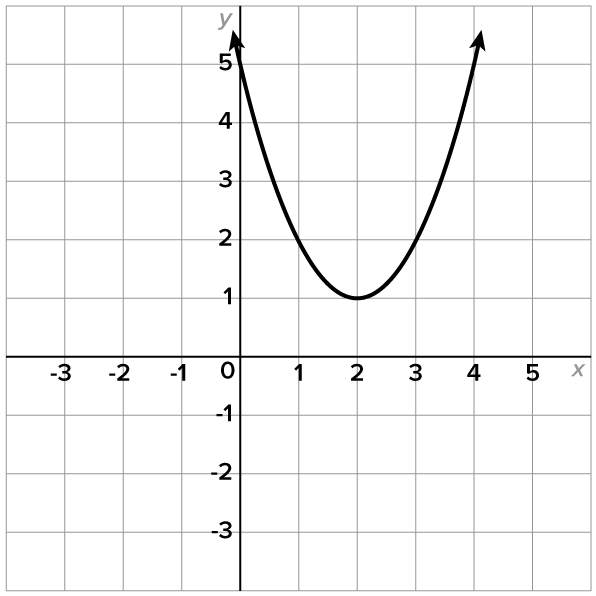
|
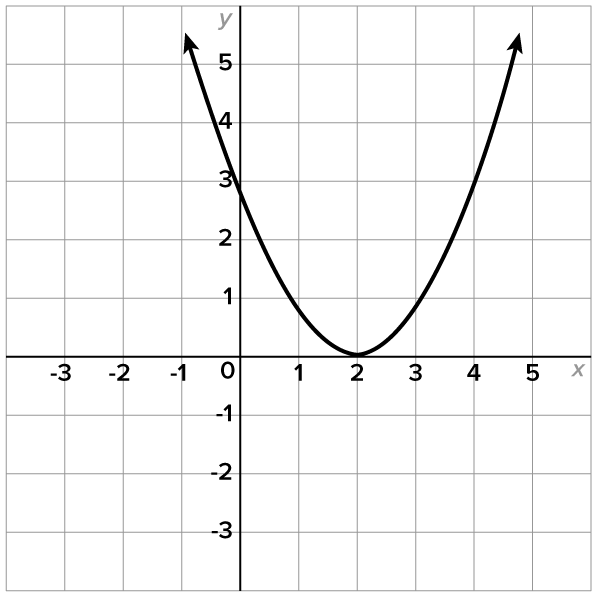
|
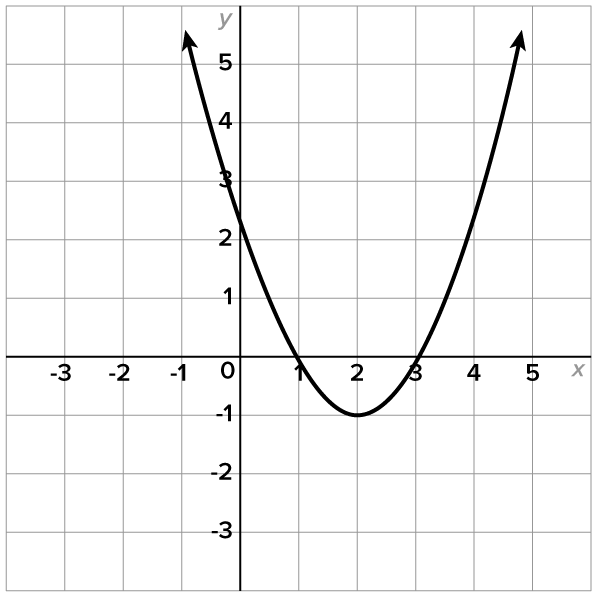
|
Based on these graphs, the graph of a quadratic function can have zero, one, or two x-intercepts. Also, note that each graph contains one y-intercept. This is true for every quadratic function.
Given a function  recall:
recall:
 and solve for x.
and solve for x.  and solve for y.
and solve for y.  has a y-intercept at
has a y-intercept at 
Finding the x-intercepts is a bit more complicated since this will involving solving 
EXAMPLE
Find all x- and y-intercepts of the graph of



 and solving for x.
and solving for x.

|
This is the original equation. |

|
Add 2 to both sides (preparing to complete the square). |

|
Add 4 to both sides. 
|

|
Write the left side as a quantity squared, and simplify the right side. |

|
Apply the square root principle. |

|
Add 2 to both sides. |
 this means that the graph of
this means that the graph of  has two x-intercepts:
has two x-intercepts: 
 and
and 
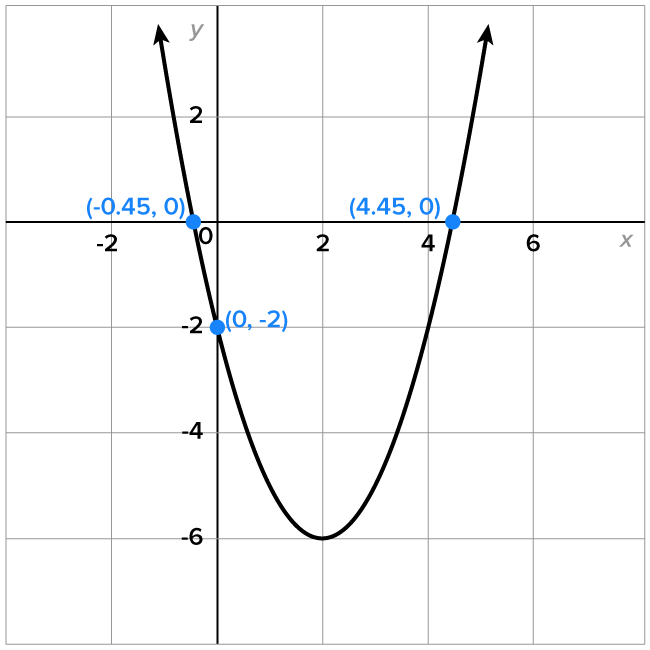
EXAMPLE
Find all x- and y-intercepts of the graph of

 and solve. This time we will use the quadratic formula.
and solve. This time we will use the quadratic formula.

|
This is the original equation. |

|
Substitute   and and  into the quadratic formula. into the quadratic formula.
|

|
Simplify. |
 is not a real number, it follows that the solutions to the equation are not real. Thus, the graph of
is not a real number, it follows that the solutions to the equation are not real. Thus, the graph of  has no x-intercepts.
has no x-intercepts.
 is shown below.
is shown below.
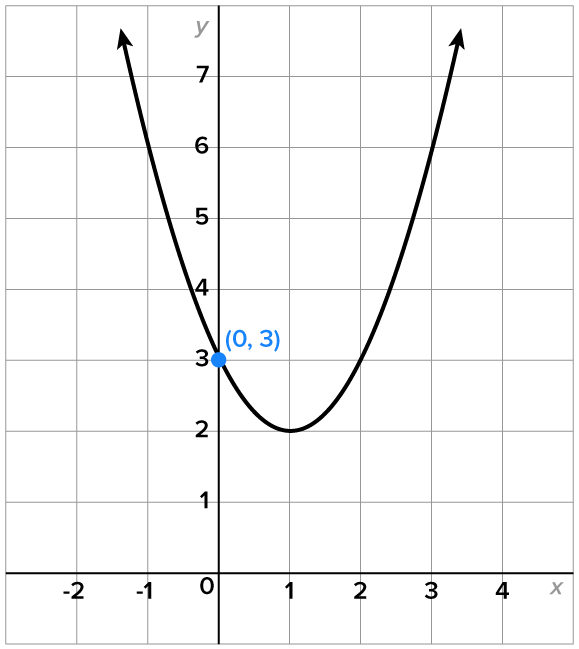
 in this video.
in this video.

In applications that are modeled by quadratic functions, intercepts give important information.
EXAMPLE
A rock is thrown upward from the top of a 112-foot cliff overlooking the ocean at a speed of 96 feet per second. The rock’s height (in feet) above the ocean after t seconds is modeled by the equation
 Then,
Then,  feet. This means that the point
feet. This means that the point  is on the graph, which is a y-intercept.
is on the graph, which is a y-intercept.
 and solve for t.
and solve for t.

|
This is the original equation. |

|
Factor out -16. |

|
Factor the quadratic. |

|
Set each variable factor equal to 0. |

|
Solve each equation. |
 does not make sense in this particular problem since t is the number of seconds after the object was thrown. Negative values of time are not considered.
does not make sense in this particular problem since t is the number of seconds after the object was thrown. Negative values of time are not considered.
 is also on the graph of
is also on the graph of  and is a t-intercept (in place of an x-intercept).
and is a t-intercept (in place of an x-intercept).
 and strikes the ocean after 7 seconds, the domain of
and strikes the ocean after 7 seconds, the domain of  is
is 
 is the vertex. Since the coefficient of
is the vertex. Since the coefficient of  is negative, we know that a maximum occurs at the vertex. In this situation, this means that after 3 seconds, the maximum height of 256 feet is achieved.
is negative, we know that a maximum occurs at the vertex. In this situation, this means that after 3 seconds, the maximum height of 256 feet is achieved.
 is shown below.
is shown below.

 where t is the time in seconds since the ball was thrown.
where t is the time in seconds since the ball was thrown.
 and solving for y, but finding the x-intercept is slightly more complicated and requires using the methods of solving quadratic equations from the last tutorial. You also learned that in real-world applications involving quadratic functions, such as a situation involving an object being launched, the intercepts provide important information about the initial height of the object and the time it takes for the object to strike a surface.
and solving for y, but finding the x-intercept is slightly more complicated and requires using the methods of solving quadratic equations from the last tutorial. You also learned that in real-world applications involving quadratic functions, such as a situation involving an object being launched, the intercepts provide important information about the initial height of the object and the time it takes for the object to strike a surface.
SOURCE: THIS TUTORIAL HAS BEEN ADAPTED FROM OPENSTAX "PRECALCULUS” BY JAY ABRAMSON. ACCESS FOR FREE AT OPENSTAX.ORG/DETAILS/BOOKS/PRECALCULUS-2E. LICENSE: CREATIVE COMMONS ATTRIBUTION 4.0 INTERNATIONAL.